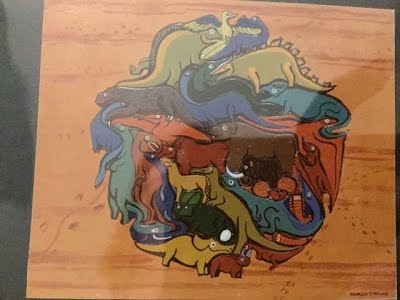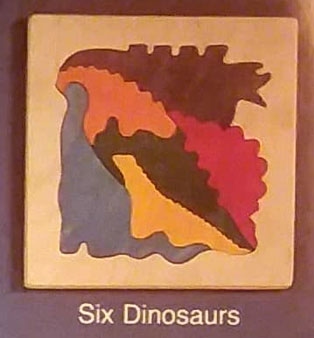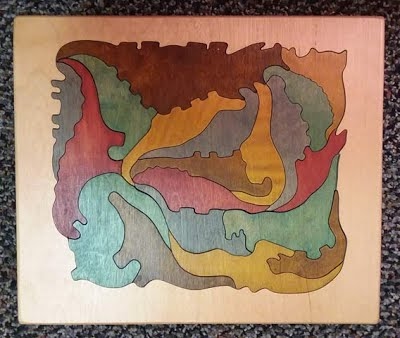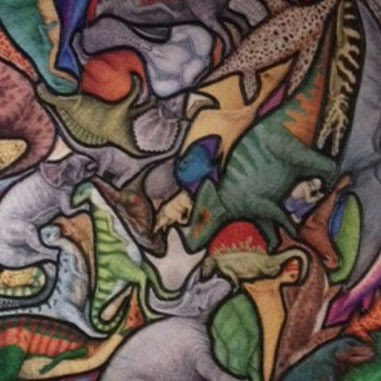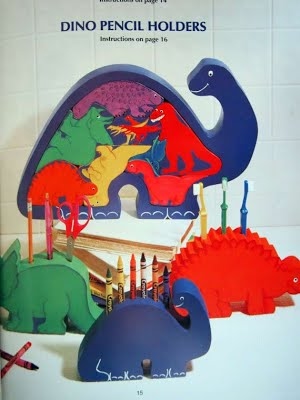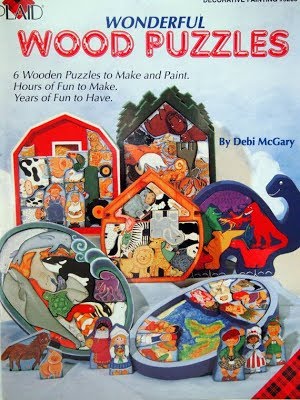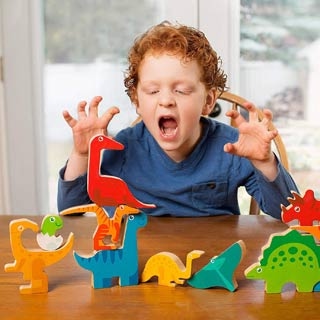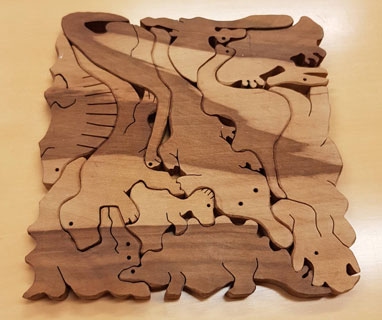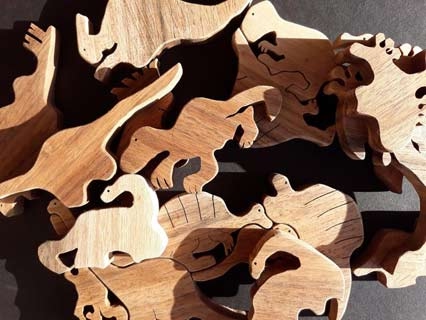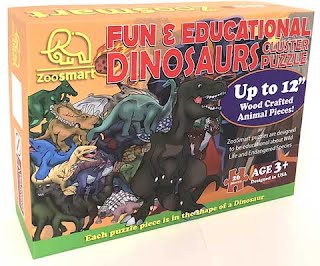Dinosaurs (along with Nativity Scenes and Countries & Continents), can be described as one of the more popular cluster puzzle themes, with nine distinct artists/designers, with eleven instances. Prominent artists who show such instances of worth include George Paulus, Stanford Graham, Sandra Ure Griffin and Demian Pedroza. The instances are presented in chronological order for the sake of general order. The 8 Artists/Designers 1. George J. Paulus 2. Sandra Ure Griffin 3. Stanford A. Graham 4. Debi McGary 5. Jean-François Tard 6. Andy Sundblad 7. Yoshiki Daito 8. Przemyslaw Remin 9. Demian Pedroza 1. George J. Paulus
Fig. 1. Extinct Animals George Jackson Paulus (8 July 1910–20 December 1995), an architect from California, USA, has, amid his extensive themed cluster puzzle range, a single effective dinosaur cluster puzzle, titled Extinct Animals, of which, as the title indicates, includes some not strictly of a dinosaur nature, such as a Woolly Mammoth. However, as the premise is overwhelming of dinosaurs, I have thus decided to place in this category. Pleasingly, unlike most of the entries here, his story can be told in full, as detailed on his dedicated page. In short, he can be described as a major figure in cluster puzzle history, with no less than 25 themed puzzles to his name. Extinct Animals is described in his generic ‘Puzzle List’ (it is not discussed in his other writing ‘Paulus Puzzles’) as: EXTINCT ANIMALS. Paulus Puzzle #10 Names on back of pieces. Some names have been changed since the puzzle was made, should be checked. Shows Archaeopteryx, Protoceratops with egg laid in Gobi desert, etc. Copyrighted, model on hand. T shirt design like this. As such, the entry is a little basic, with only two named dinosaurs and without any other relevant detail. However, most, at least of the more known to the layman, are easily recognizable, such as Pterodactyl and T. rex; others I am less sure. However, all the indications are that the extinct animals/dinosaurs are indeed true representations and not generic, as the listing above gives specific names on the reverse, of which I have not seen. About 29 motifs are discerned, from the single image I have, and of which the definition between the creatures is not always obvious. Each dinosaur is mostly coloured in a simple manner, with a broad single colour; on occasion, there are two colours. The interior detail is to an Escher-level degree. As a broad, simple statement, I find favour with these. The silhouettes are, in most cases, convincing. 2. Sandra Ure Griffin/Pacific Puzzle Company Sandra Ure Griffin, an artist from Kansas City, US has, amid her extensive themed cluster puzzle range for the now (defunct) Pacific Puzzle Company* (PPC), of Anacortes, Washington, US two dinosaur cluster puzzles, simply titled after the number of motifs, Six Dinosaurs and Nineteen Dinosaurs. Pleasingly, unlike most of the entries here, her story can be told in full, as detailed on the generic page. In short, she can be described as a major figure in cluster puzzle history, with no less than 12 themed puzzles to her name. This was undertaken as a commercial nature, with the puzzle marketed by PPP under brothers Ian and Lee Woofenden. Each dinosaur (as indeed are all her puzzles) are portrayed simply, by silhouette, in wood, of a single painted colour. As a broad, simple statement, I find favour with these. The silhouettes are, in most cases, convincing. My personal preference of an optimum presentation is for interior detail to be added, but this style/presentation is still more than acceptable. Upon general correspondence on the puzzle regarding which puzzle sold the best, Lee told me: I think the dinosaurs puzzles sold moderately well... but Ian might remember better. [Ian] Correct, within the scale of the bootstrap, craft business that it was. This is broadly to be expected, as dinosaurs are a popular theme in general, not just on puzzles, but on just about every artefact, clothing in particular; once primed one sees dinosaurs everywhere (I speak from experience!) *Not to be confused with a 2020 start-up jigsaw puzzle company of the same name. Acknowledgements (in chronological order as to research); Anne Williams, for kindly drawing the PPC company to my attention. Sandra Ure Griffin, for making contact upon seeing my request for further details on Pacific Puzzle Company on the page. Ian Woofenden, for Pacific Puzzle Company background, pictures of the puzzle, brochures, and general details arising from the puzzles. Lee Woofenden, for Pacific Puzzle Company background, and general details arising from the puzzles. 3. Stanford A. Graham Fig. 3a. An Amazing World of Dinosaurs box. Fig. 3b. An Amazing World of Dinosaurs detail Stanford A. Graham, an attorney from Layton, Utah US, has, amid his three themed, commercial cluster puzzles a single dinosaur cluster puzzle, titled An Amazing World of Dinosaurs. The puzzle is US patented (and apparently his only one) and marketed as a jigsaw-type puzzle under the Anything's Puzzable label, of a large 25¾” circular composition, of 75 pieces, and is dated c. 1996. It comes with an accompanying brochure. However, although detail on the puzzle in the round is known, there is surprisingly little background details on Stanford A. Graham himself. All that is known is that he is an attorney, his home address, and that's about it! He has no web presence at all; no website, no email address, and no social media (Twitter, Facebook, and Instagram). There is no indication as to his age or interest in puzzles or art. Obviously, he has a degree of artistic leanings. The catalogue states: A LARGE 25¾ “ circular puzzle with 75 sturdy, interlocking Animal-Shaped Puzzle Pieces for all ages from Hatchling to Extinct Travel back through time and discover An Amazing World of Dinosaurs. Choose your favourite true-to-life, prehistoric creatures, then turn the piece over and discover its name, how big it was, when it roamed the earth [sic] and where it lived. If you love dinosaurs, enjoy a challenge, or treasure beauty, you will love AN AMAZING WORLD OF DINOSAURS. As is made clear in the catalogue, these are of an educational plaything nature, with details of the individual creatures on the reverse (also see the earlier (1994) Pieceful Solutions puzzle of a like idea). No mention of Graham himself is made in the catalogue. The website is defunct, at least of 2016 when first researched, and likely much earlier). Interestingly, the extensive (eight-page) patent discussion quotes Schoonderbeek, below, and many others, of less obvious connection to the genre. It is not entirely clear if this extensive listing is from Graham’s research or the patent examiner. Given the extent and depth, I lean towards the examiner. However, given that it appears in the main body of the text, it does indeed to be from Graham, and so I will take this research at face value from him. Schoonderbeek reference (p. 6): Numerous puzzles are known. Schoonderbeek, FR 922, 298 illustrates interconnecting puzzle pieces fitting within a template board shaped as animals, humans, etc. which can be disassembled to form individual play items. He then continues with other designers. However, Graham qualifies this long listing with (p. 7) None of the foregoing provides a puzzle with interconnecting pieces, the shapes of which depict anatomically accurate animals or realistically depicted related items. These puzzle pieces have one side illustrated with a picture of the animal or item, and also include scientifically accurate information on the side opposite the illustration. Said pieces can be disassembled to form individual play items, or assembled and used as an educational instructional aid. The invention described below provides such an invention. However, the Schoonderbeek instance surely contradicts this. There is the occasional reference to the dinosaur puzzle: In one preferred embodiment, the puzzle pieces are shaped as dinosaurs with one side of the puzzle pieces are colored and patterned to show the exterior of the dinosaur, and the other side of the puzzle pieces is colored and patterned to show the skeletal bone structure of the animal. To fit within irregular spaces between the interfitting appendages of the dinosaurs when the puzzle pieces are assembled, some of the puzzle pieces may be shaped as paleontologists searching for dinosaurs, teeth, claws, or other items that may be found at a dig site. A full inventory is not given the brochure or patent. The patent mentions just one motif, a Megalosaurus. However, many more are easily recognisable to the layman, such as a plesiosaur, and likely many more to the dinosaur enthusiast. Obtaining the puzzle is not easy; it appears to have been discontinued. It is ostensibly to be seen on Amazon, but this is then stated as ‘currently unavailable’. As a broad, simple statement, I find much favour with these, and like these very much. The dinosaur silhouettes are, in most cases, convincing, identifiable, and with realistic rendering, of appropriate interior detail, and of the higher principles of tessellation, without any gaps. Can anyone add more to the above? In particular, does anyone know of Stanford A. Graham? Are you there, Stanford? Do tell me your story! 4. Debi McGary Debi McGary, of Rexburg, Idaho, US, has a single dinosaur cluster puzzle, titled Dino & Friends, amid her six themed cluster puzzle range, published in the book Wonderful Wood Puzzles, of 1996. However, very little is known of her, and what there is is mostly from the (self-published?) book, and snippets on the web, not all of which are accessible to me in the UK! A ‘451: Unavailable due to legal reasons’ appears when I click on a relevant page. Eight dinosaurs are shown within an overall dinosaur outline, but as is clearly to be seen, the tessellation principle is considerably relaxed as there are considerable gaps (as is also the case with her other puzzles). Of course, she may not be approaching this as according to the stricter standards of tessellation, and so such critical comments are out of place, at least in an arts and craft sense here as it appears to be. The style is plainly of a children’s puzzle. Each dinosaur is portrayed simply, of a single, bright colour, and appropriate interior detail. The puzzle has an additional purpose as a pencil holder, as shown by the picture (the only instance of its type, although not of any intrinsic added value per se, as just about any puzzle could be so adapted). Pleasingly, she at least intuitively understands the nature (and desirability) of themes, as all her other puzzles are of a like nature. The book has an about page, which gives at least gives a modicum of background detail: Debi McGary is the mother of six children and has enjoyed designing puzzles for them. She is now pleased to share her creations with you. Noah's Ark puzzle was the first puzzle she designed in order to have a special toy just for Sunday. She couldn’t find a published pattern that she liked so she designed her own. Debi and her husband, Steven, spent the first five years of their marriage on the family farm in Washington State … Debbi is now working on a book on holiday puzzles. The ‘follow-on’ book on holiday puzzles is not known. She has no known website. She and her husband have a joint presence on Facebook, but no other social media (Twitter and Instagram) as of this writing. Her Facebook page does not show these puzzles. Both seem interested in the church. And that is about all that is known about her! Nothing on the dinosaur puzzle, or her other cluster puzzles in general, is shown. Ideally, I would have the book to hand to aid in the review, but I decided against obtaining the book on time matters; I cannot do everything! I have seen sample pages on eBay, this judged broadly sufficient. As such, it seems primarily on plans for the puzzles, for the artist to copy, rather than discussions as such. The puzzle interest seems to have ended with the publication of the book.
Acknowledgements My thanks to Anne Williams for drawing the work of McGary to my attention.
References McGary, Debi. Wonderful Wood Puzzles, Plaid, 1996, 27 pp. Self Published? 5. Jean-François Tard/Michèle Wilson Company Fig. 5a Dinos en Folie box and individual pieces. Fig. 5b Dinos en Folie puzzle Jean-François Tard or François Tard of France, has a single dinosaur commercial cluster puzzle (amid his three-themed cluster puzzle range of jigsaw puzzles), titled Dinos en Folie (Crazy Dinosaurs), for the Michèle Wilson Company. The puzzle is widely distributed in France. However, nothing is known of him! Upon contact with Julien Vahanian of the company, an email was forwarded to him, but he did not respond. Upon searching social media, it does not appear that he is on Twitter or Facebook. There is a plausible artistic reference on Instagram to him, but it is not definite. Likely, he is an artist of some description. The quality of the artwork of the puzzle is very good indeed, with each dinosaur rendered in a life-like way, much more so than other people. The silhouettes are convincing, with easily recognisable dinosaurs, with appropriate interior detail, and of the higher principles of tessellation, without any gaps. As a broad, simple statement, I find much favour with thIs, and like it very much. The puzzle is dated 2015, and is of 24 pieces, a reasonably high number, and costs 25. There does not appear to be documentation with the puzzle, and the box detail is sparse indeed of only the most basic detail, although the designer is indeed credited, unlike most: PUZZLE EN BOIS (wooden puzzle) DINOS EN FOLIE (crazy dinosaurs) TARD (designer’s name) PUZZLE - 24 PIECES DÉCOUPE À LA MAIN (cut by hand) FABRIQUÉ EN FRANCE (made in France) WOODEN JIGSAW PUZZLE HANDCUT & MADE IN FRANCE Can anyone add more to the above? In particular, does anyone know of Jean-François? Are you there, Jean-François? Do tell me your story! 6. Andy Sundblad Andy Sundblad, a graphic designer and illustrator of Oakland, California, US, has a single dinosaur commercial cluster puzzle, for his company Oaktown Supply, titled DinoPuzzle, in (unspecified) wood, of 11 pieces. This is described as: Fun Dino Design - Create a Colorful Jurassic World: Ideal for boys and girls, our DinoPuzzle features bright and cheerful renditions of beloved favorites like Stegosaurus & Triceratops. Designed for Small Hands: Kid puzzles should be easy for little hands to maneuver. Ours features chunky pieces that can actually stand on their own for exciting dinosaur adventures. Fosters Learning & Creativity: This jigsaw puzzle looks simple… but it’s actually a powerful developmental tool that builds motor and cognitive skills and ignites your child’s imagination… This solid-wood puzzle features a bright ensemble of colossal creatures including Spinosaurus, Stegosaurus, Sinopterus, Tyrannosaurus Rex, Pterodactyl, Brontosaurus, Triceratops, Velociraptor, Baby Brontosaurus, Parasaurolophus & Hydrotherosaurus. Made for toddlers,... The puzzle is designed as according to looser tessellation principles, with notable gaps and introduced articulations, and so this is very much of a lower tariff of difficulty. However, it is by far from a mere push-fit puzzle. Likely the designer is not familiar with the higher principles of tessellation and so in these circumstances criticism is unwarranted. Within this easier type to achieve, the silhouettes are convincing, of a consistent style, with easily recognisable dinosaurs, with appropriate interior detail. Each dinosaur is rendered in a simple, child-centred way, of one core bright colour with secondary colours of a darker shade of the core colour. The puzzle is available from themselves and on Amazon and retails for $21.97. It comes with a tray, in which a guideline is offered, with named places for the pieces. There does not appear to be any documentation with the puzzle and it is supplied in the tray, without a box. Within its lower tariff context, the puzzle is pleasing. Like most cluster puzzles, there is a dual purpose here as a playset. The puzzle is not dated but appears to be of 2020. Oaktown Supply describes themselves as: Oaktown Supply is a small product design company that hangs its hat in Oakland, California. We create custom-designed journals, maps, toys, gifts and a growing array of new items as well. https://www.amazon.com/Dinosaur-Puzzle-Wood-Jigsaw-Toddlers/dp/B078VGG5S5 7. Yoshiki Daito Yoshiki Daito, a woodworker of Yamanashi, Japan has a single dinosaur commercial cluster puzzle (amid three others), from his woodworking studio ‘Iglehaus’, titled Dinosaur Puzzle, in plywood, of 11 pieces. The accompanying text to the puzzle on the website is mostly of basics, and does not discuss the intricacies of the puzzle as such. However, it does indeed (unlike most others) give a listing of the dinosaurs: Protoceratops, Brachiosaurus, Triceratops, Tyrannosaurus, Apatosaurus, Plesiosaurus, Pteranodon, Pterodactylus, Ankylosaurus, Stegosaurus, and Iguanodon. The dinosaurs are mostly easily recognisable, at least those that are more familiar to the layman in the field (such as myself, of eight). The puzzle is designed as according to looser tessellation principles, with occasional gaps and introduced articulations, and so this is very much of a lower tariff of difficulty. That said, it does indeed possess true tessellation principles as well, and so it is not merely a ‘push-together’ puzzle. In short, it can be described as a broad ‘in-between’ the two types. Each dinosaur is rendered in a simple, one muted stained colour with Escher-like interior detail. The puzzle is in two sizes, 460mm×420mm and 760mm×700mm and the smaller are available from themselves for ¥13000 (£95.40). The larger puzzle, of 24 mm plywood, is made to order and is not apparently priced. The extra thickness gives it the possibility of a play puzzle as well. The puzzle is not dated. I first became aware of this in *. As a broad, simple statement, of its type, I quite like this, albeit qualified by the lower tariff of difficulty and the relatively few dinosaurs which do not always require lines of a higher tariff double contour. http://igelhaus.com/puzzle_e_data/dinosaurs_e.html 8. Przemyslaw Remin Fig. 8a. Jurassic Puzzle, of 11 pieces. Fig. 8b. Jurassic Puzzle, of 19 pieces Przemyslaw Remin, of Warsaw, Poland, a statistician and an amateur palaeontologist with a tessellation interest, has three dinosaur artisanal cluster puzzle on his ‘Gondebas’ Etsy page, titled ‘Gondebas Jurassic Puzzle’, of 11 pieces and ‘Gondebas Jurassic Puzzle, dissection of a square to an equilateral triangle’, of 18 pieces. Oak and walnut wood are used respectively. Each is described, with minor corrections as to the English and spelling: Puzzle 1 - 11 Pieces Jurassic Puzzle. Every dinosaur is good on its own, yet they all interlock. ...T-rex, triceratops, diplodocus, brachiosaurus, sarcosuchus, crocodile, pachycephalosaurus, pteranodon, rhamphorhynchus, dimetrodon, stegosaurus. You may put them together into a square. It was cut from one piece of red oak wood. What is unique about this puzzle is that each set has alternative solutions. If you think you could assemble it, well, not that quick. This set can also be assembled into a trapezium. Those of you who love statistics can put it together into a shape similar to a Gaussian curve. Puzzle 2 - 11 Pieces Set of 11 dinosaurs. An exceptional grain pattern and colors. This set was cut from one piece of cherry. This is a unique piece of wood. The grain texture here, with its wonderful colors and structure, make it a wooden jewelry. This piece of wood has natural stains. There are red stripes, shades of green and beautiful black spots. The heartwood of this tree clearly contrasts with sapwood. The board was so beautiful in itself that I was sorry to cut it. After assembling all the elements of this dinosaur mosaic, you can take one dinosaur, put it on the other edge of assembled puzzle and it also fits there. That way, you may always take the dinosaurs from one side of the mosaic and lay them to the other side of the puzzle. The whole puzzle will start to walk on the floor. This set can walk in a straight line to infinity. During this dinosaur journey, different puzzle solutions emerge. One solution is a square, another is a volcano shaped trapezium. And a treat for lovers of statistics, with a little imagination, they will be able to recognize in one of the solutions the bell of the Gaussian curve. Puzzle 3 - 19 Pieces Dinosaur puzzle set, deity level difficulty. 18 dinosaurs. Each creature is good on its own, yet they all interlock, forming bigger geometric shapes. The beasts have been cut from one piece of walnut wood square. Amazing grain patterns may lead you to the easier solution, a square. But watch out, there are traps set on you. This puzzle set has hidden alternative solutions which allow you to discover the beauty of geometric transformations. The most perilous objective of this set is an equilateral triangle. No one has ever discovered that solution. Even putting together the square is a very difficult task. Everybody is tempted by the small number of pieces but most of the people resign after a few hours. You may wonder what inspired me to create this puzzle. The other day I came across a copy of a paper published in 1809 presenting a remarkable geometric riddle. It was a mathematical dissection of a square into an equilateral triangle. I was so stunned by its beauty that I put everything else aside and worked on sketching this puzzle. Never before had I been so motivated to accomplish a project. I have cut out only three sets of that pattern so far. Each set is different. The first original set was too difficult for the people to assemble even its basic solution, a square. So in the second and third edition I reduced the gaps and improved the shapes of the creatures. I am particularly proud of the shape of rhamphorhynchus. Rhamphorhynchus was a flying reptile with a tail ended with a diamond-shaped vane. All my puzzle elements are meant to resemble real fossils. The oldest one in this set is dimetrodon living in the Permian period. It lived 295 million years ago, 40 million years before the first appearance of dinosaurs. Dimetrodon is more closely related to mammals than to modern reptiles. There is a story behind each creature that takes part in this puzzle. I am still under the spell of an ammonite fossil, sort of an ancient snail, I found in the quarry as a youngster. This fragile being lived a couple of years some 200 million years ago. And yet I held it in my hand. I proudly present you this piece of wooden puzzle art. You got a bunch of teasing dinosaurs, amazing patterns of walnut grain, deity level difficulty, fascinating paleontologist story behind each creature, and yet mystique triangle solution. You dive into geometrical entertaining riddles. If you never heard of tessellations, well, this is one. One of a kind. A curious feature from the above is that the puzzle has no one solution. Different assemblages are possible, including a square and triangle, although none are shown on the Etsy pages, his prime outlet. Rather, the puzzle is depicted in various states of incompleteness and pieces in isolation. However, the other assemblages are indeed shown elsewhere, on a ‘StackExchange’ site and his 7.58 video (and incidentally of which is very nicely produced, and discussed below). Presumably, this omission on Etsy must have been purposeful, although highly unusual; I do not know of any other puzzle not shown in a very near (i.e. one or two pieces ‘loose’) or complete state! The ‘multi-assembling’ feature is quite interesting and to the best of my knowledge not seen elsewhere on representational cluster puzzles. However, I am unsure of the significance here (to be investigated). Pleasingly, all the dinosaurs are listed, and so comparisons between the pieces and the true representation of the motifs can be made. The dinosaurs are mostly easily recognisable, at least those that are more familiar to the layman in the field (such as myself; I clearly recognise seven). The puzzle is designed as according to looser tessellation principles, with occasional gaps and introduced articulations, and so this is very much of a lower tariff of difficulty, and so is this easier to accomplish in veracity than strict observance of a true tessellation. That said, it does indeed possess true tessellation principles as well, and so it is not merely a ‘near anything goes, push-together’ puzzle. In short, it can be described as a broad ‘in-between’ the two types. The design and finish are consistent, with a simple interior detail of an eye, with interior line detail. The wood is left uncoloured. The puzzle retails, at a variety of prices on Etsy, of $491, $1475 and $2,700, which suggest three distinct puzzles. In comparison to others, it does seem overpriced and from the page statistics he has not sold any. However, of a more sensible pricing, I am sure that there will be purchasers ‘Gondebas’ as a term is not apparently dinosaur-related; it appears to be a user name applied solely to Etsy. The puzzle is not dated, but appears to be ‘recent’, loosely stated, likely in the last few years. The size of the first puzzle (11 Pieces) is height 5½”, width: 5½”, depth ⅜”. The 18-piece is not given. As alluded to above, the video is very nicely produced (by himself), and well worth viewing. Among its features are the puzzle being cut, and a chance encounter with people in a cafe assembling the puzzle. Also included is a brief discussion on different types of wood used, some of which were new to me. As a broad, simple statement, of its type, I quite like this, albeit qualified by the lower tariff of difficulty and the relatively few dinosaurs (11) of the first two puzzles. A main attraction for me is the variation of the square to triangle possibility (and vice versa), an innovation not seen elsewhere. Etsy pages: https://www.etsy.com/hk-en/listing/755837463/gondebas-jurassic-puzzle-handmade-11 https://www.etsy.com/listing/759925151/gondebas-jurassic-puzzle-tessellation https://www.etsy.com/uk/listing/758364025/gondebas-jurassic-puzzle-dissection-of-a?ref=related-2&frs=1 Video: 9. Demian Pedroza Demian Pedroza, of Washington DC, US, has (within their ZooSmart range; also see the generic page entry), created a single dinosaur-themed cluster puzzle in 2021 (with artwork by *) titled ‘Fun & Educational Dinosaur Cluster Puzzle’. Surrounding the puzzle is a prehistoric backdrop, with active volcanoes and an incoming asteroids echoing the KT extinction event. There are 26 pieces in wood, measuring 26” x 18” when assembled. The puzzle is with commercial intent and is available through Amazon (below) for $24.99, plus shipping. As the title alludes to, this is both a plaything in its own right and an educational puzzle. On the reverse of each piece is each dinosaur's name, with a QR code to scan to learn more about the dinosaurs. The dinosaurs included well-known instances such as T. rex, Brontosaurus, Triceratops, and Pterodactyl, along with others less well-known, such as Pinacosaurus, and Coelophysis. The graphics are very nice indeed, of which within any one dinosaur is a broad single colour of a 3D rendering. The silhouettes are, in most cases, convincing. As a broad, simple statement, I find favour with these. Table of Attributes For the sake of having all aspects readily at hand to examine and assess, below I compile a ‘table of attributes’ of the puzzles above, The table includes the artist/designer, title, date, the number of dinosaurs. So what can be drawn from all this? A noticeable instance, in terms of an outlier in numbers of motifs, is that of is that of Stanford A. Graham, with 75 motifs, with the next largest number being 29 (by George Paulus). Typically, the instances here are of much lower numbers; for instance six of the puzzles range from just 6-11 motifs. Essentially, there is little interest by anybody in a series, as only Sandra Ure Griffin and Przemyslaw Remin, show more than one, and both these people show just two. Examining the dates, of which most are known, or can be surmised with reasonable certainty, these are all, save for George Paulus 1958 work, ‘modern’, from 1986–1992 onwards. This is perhaps a little surprising, given the popularity of the motif, and with numerous (relatively speaking) non-related cluster puzzles predating the 1980s instances onwards. ¹ The exact date is lost in the mists of time. However, all the puzzles from Ure are dated 1986–1992 ² Full title: 8a Jurassic Puzzle, dissection of a square to an equilateral triangle, deity level 8b Jurassic Puzzle handmade 11 dinosaurs Conclusion Overall, I pleasingly generally find favour with most of the works here. Most have artistic integrity, and only a few are of a noticeably lesser quality. Of particular note are the works of George Paulus, Stanford A. Graham and Sandra Ure Griffin. These all have artistic integrity, are of convincing silhouettes, of high numbers of motifs (29, 75 and 19 respectively) and of the higher standard of tessellation, without gaps. What more is there left to like! François Tard and Yoshiki Daito’s work is also worthy of praise. Within a looser definition of tessellation, of gaps, Andy Sundblad’s work is pleasing. Przemyslaw Remin’s work is difficult to assess. The puzzle possesses a certain novelty, not seen on others. However, included here are gaps, but these are not excessive. Debi McGary’s puzzle has noticeable gaps, much more so than can be considered acceptable in the strictest, or looser sense, of tessellation. Most of the works here are likely independent discoveries, as the designer does not refer to any preceding instances. However, Paulus was seemingly influenced by Escher’s Plane Filling I and Plane Filling II and Graham was certainly influenced by Schoonderbeek. Page created and completed as Release 1, 30 October 2020. Demian Pedroza added 11 August 2021 |
Cluster Puzzles >
